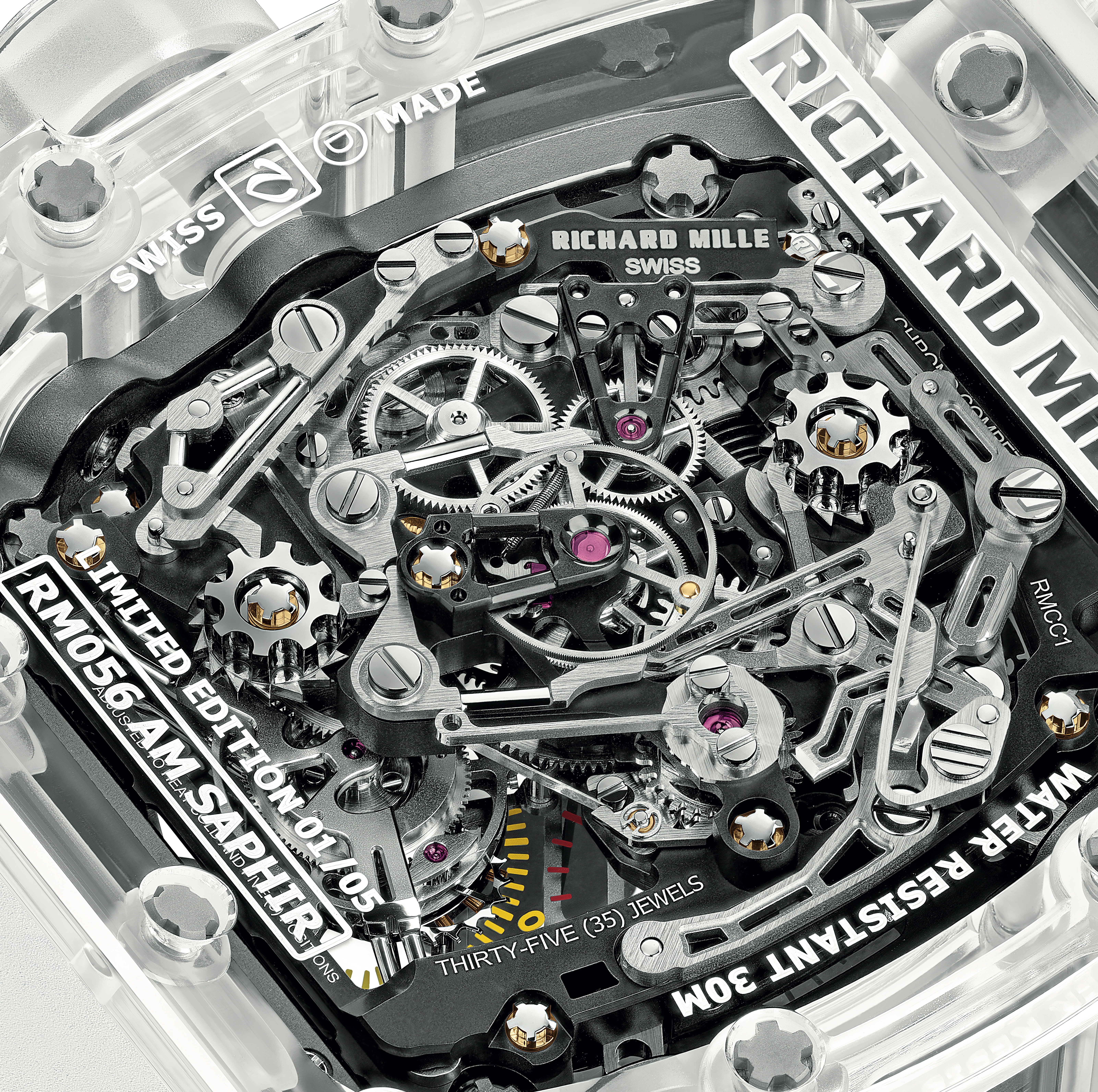Richard Mille: The man who went from carving watches out of soap to making timepieces for Rafael Nadal and Lando Norris — and built a £1bn business in the process
A new coffee table book by Assouline celebrates one of today’s most daring and innovative watch brands.


Richard Mille contradicts the rule that says in order for a watch brand to be a household name it must either be centuries old, make millions of watches or preferably both. Unlike Rolex, Omega or Cartier, Richard Mille makes barely 6,000 watches a year. It has been around for just a quarter of a century, and in that time, despite making fewer watches in its history than Patek Philippe makes in a year, it has achieved a fame — some would say notoriety — that far outstrips its stature as an independently owned brand.

Richard Mille: The Impossible Collection (£1,150) celebrates a watch brand that's shot to global fame despite producing fewer than 6,000 watches each year.
As a new coffee table book Richard Mille: The Impossible Collection, published earlier this month by Assouline tells us, the brand did so by making the most ambitious, outlandish and resolutely futuristic watches, putting them on the wrists of stars including Rafael Nadal, Felipe Massa and Sylvester Stallone, and charging an average of £250,000 each. That propelled it not only into the popular consciousness but into Switzerland’s billion-dollar club, an elite group of only seven watch brands.
This much, you may already know. But the book, written by French journalist Fabienne Reybaud, adds plenty of detail on the brand’s early years — as well as insights into what could have been. It can be hard to remember, for example, that at the outset it was just like so many ambitious start-ups: Mille couldn’t afford a stand at the 2001 Baselworld trade fair, and instead took private meetings during which he startled press and retailers by hurling his prototype RM001 watch across the room to demonstrate its shock resistance. Before he could afford high-tech machinery, he carved the shape for his signature ‘tonneau’ case out of a bar of soap.
Mille had a watchmaker’s fascination with the mechanical, but not the technical aptitude — recalling that he disassembled his first watch, but completely failed to put it back together. Instead his genius was in translating his love of machines into new ideas, convincing others to make them despite the difficulty and marketing the hell out of them. One of his early jobs — he only began his own brand at the age of 49 — was for the little-known French brand Yema. Mille scored a marketing coup by persuading the brand to make a watch out of titanium and send it to the North Pole on an explorer’s wrist. It would set the playbook for his eponymous work, but even that could have turned out very differently. Reybaud notes that in 1999, when Richard Mille launched, he was propositioned by Jean-Claude Biver, the executive (and fellow marketing god) who had revived Blancpain and would go on to work his magic at Omega, TAG Heuer and Hublot before running LVMH’s watch division. It could have been a perfect match, or it could have driven Richard Mille into the arms of the luxury conglomerate groups, but sensing that the two men could not reconcile their similarities, or egos, Mille passed on the offer.

Richard Mille's love of cars inspired his eponymous brand and its official tagline: 'a racing machine on the wrist'.
What resulted is one of the most remarkable bodies of work in modern watchmaking. Mille himself has now ceded control of the business to his children — and those of his long-term business partner Dominique Guenat — so as the company enters its second act, we thought we’d remind you of 12 watches featured in The Impossible Collection that epitomise the brand’s story so far.
- RM001 The very first prototype, of floor-flinging fame. Cased in gold with an incongruous leather strap, it was worn by Mille for years before being sold to F1 supremo Jean Todt. It would later sell at auction in 2022 for CHF 2.094m
- ‘Richard Mille by Starck’ A one-off created by industrial designer Philippe Starck for the charity auction Only Watch, it had a clasp operated by a button on the side of its titanium case. Even die-hard Richard Mille fans might have forgotten this one. Selling in 2005 for €285,000, it was something of a bargain in the long run
- RM 020 Despite having a clear aesthetic, over its 25 years Richard Mille has tried its hand at most types of watches, including in 2008 a pocket watch. With a baseplate in carbon nanofibre and a chain to match its 21st century style, it was a singularly avant-garde take on the 19th century cliché
- RM031 Round watches have never symbolised Richard Mille in the way the RM001 shape does, but there have in fact been many. This is a rare example, however: a 10-piece limited edition housing a highly accurate chronometer movement, rated to plus or minus 30 seconds a month (a chronometer certified watch is permitted to lose up to four, or gain up to six, seconds per day). It was Richard Mille’s way of saying that although not the brand’s priority, it could compete on traditional grounds as well as establishing new ones

The view inside the caseback of the RM 056 'Felipe Massa' Manual-Wind Sapphire Tourbillon Split-Seconds Chronograph.
- RM056 Talking of establishing new grounds… the launch in 2012 of the first watch cased entirely in sapphire crystal took the establishment by surprise, even after a decade of daring creations. It would prove one of the most influential moves on Mille’s part, prompting sapphire cases from imitators for years to come

- RM27-01 In 2013, Richard Mille suspended the entire movement of a watch within its case with tiny steel cables, and gave it to Nadal (above) to prove the shock-absorbent properties of such a radical — and eye-catching — idea.
- RM 59-01 In the same year, it also equipped sprinter Yohann Blake with this Jamaican-themed tourbillon. Cased in a composite material shot through with carbon nanotubes, it fired the starting gun on a decade-long trend for bold colour and experimental case materials
- RM69 Arguably one of its more controversial launches, in 2015 Richard Mille debuted the smutty, innuendo laden RM69 which, powered by a 69-hour power reserve, used mechanical rollers to generate up to 216 statements of, er, romantic intent
- RM19-02 Once again proving that it could dabble in even the most traditional art forms, Richard Mille launched its first automaton watch in 2016: a gem-set watch with a magnolia flower whose petals opened and closed mechanically on demand
- RM 25-01 Inspired by Sylvester Stallone’s Rambo, Richard Mille took a ‘kitchen sink’ approach to designing a survival tool watch. On top of a chronograph and 24-hour timer, it packs a compass, a mirrored cover and a compartment for tiny water purification tablets
- RM 07-03 ‘Marshmallow’ The arrival in 2019 of an entire range themed around meticulously-crafted depictions of pick-and-mix sweets baffled onlookers (and sold out just as quickly as their sporty counterparts). Hindsight yet again shows it to have been a prescient move, as watch brands have embraced whimsical, illusory and often childish inspiration in droves since the pandemic
- RM 52-05 Finally, a watch that saw Richard Mille collaborate with multi-hyphenate creative Pharrell Williams, who imagined an astronaut standing on the surface of Mars looking back at Earth. Executed in traditional decorative techniques, it’s a fitting design for a brand that has never stopped dreaming of the future — and in many cases, willed into existence
Exquisite houses, the beauty of Nature, and how to get the most from your life, straight to your inbox.
Chris Hall is a freelance writer and editor specialising in watches and luxury. Formerly Senior Watch Editor for Mr Porter, his work has been published in the New York Times, Financial Times, Esquire, Wired, Wallpaper* and many other titles. He is also the founder of The Fourth Wheel, a weekly newsletter dedicated to the world of watches.
-
 What trees taught me about perfect planting — Alan Titchmarsh
What trees taught me about perfect planting — Alan TitchmarshSense and patience is key to growing healthy trees, as a certain Mr Mackenzie showed a young Alan Titchmarsh
-
 What on earth is the person who comes up with Annabel's otherworldly facade displays on? London's most magical Christmas shop displays
What on earth is the person who comes up with Annabel's otherworldly facade displays on? London's most magical Christmas shop displaysPhotographs by Greg Funnell.
-
 Sweet civilisation: What do you get when you ask architects to compete in a gingerbread competition?
Sweet civilisation: What do you get when you ask architects to compete in a gingerbread competition?The Gingerbread City is back in London’s Kings Cross. Lotte Brundle pays it a visit.
-
 Sophia Money-Coutts: A snob's guide to meeting your in-laws for the first time
Sophia Money-Coutts: A snob's guide to meeting your in-laws for the first timeThere's little more daunting than meeting your (future) in-laws for the first time. Here's how to make the right kind of impression.
-
 This machine is what happens when the Rolls-Royce of motorbikes and the most innovative of watchmakers join forces
This machine is what happens when the Rolls-Royce of motorbikes and the most innovative of watchmakers join forcesBrough Superior and Richard Mille, two brands renowned for perfection, have created something that is exactly that.
-
 ‘Each one is different depending on what mood I’m in, how I'm feeling and how my energy is’ — meet the carver behind Westminster Hall's angel statues
‘Each one is different depending on what mood I’m in, how I'm feeling and how my energy is’ — meet the carver behind Westminster Hall's angel statuesBespoke woodcarver William Barsley makes unique scale replicas of the angels that gaze over Westminster Hall, the oldest part of the palace of Westminster.
-
 If chess is 'the supreme board game', then it deserves to be played on boards like these
If chess is 'the supreme board game', then it deserves to be played on boards like theseChess sets and backgammon boards are a familiar sight on drawing-room tables, but one expert Highland woodworker is refashioning their forms in beautiful new ways.
-
 What is everyone talking about this week: Thanks to modern-day technology, people were far happier in the days when Nero was setting Rome ablaze
What is everyone talking about this week: Thanks to modern-day technology, people were far happier in the days when Nero was setting Rome ablazeWas the ancient world's superior happiness down to its ‘superior production of art’?
-
 A slick looking off-roader that's a far cry from its rustic rural roots — Volvo EX30 Cross Country
A slick looking off-roader that's a far cry from its rustic rural roots — Volvo EX30 Cross CountryThe latest iteration of Volvo's Cross Country is flashy, fast and stylish. But is that what a Volvo Cross Country is supposed to be?
-
 ‘I cannot bring myself to believe that Emily Brontë would be turning over in her grave at the idea of Jacob Elordi tightening breathless Barbie’s corset’: In defence of radical adaptations
‘I cannot bring myself to believe that Emily Brontë would be turning over in her grave at the idea of Jacob Elordi tightening breathless Barbie’s corset’: In defence of radical adaptationsA trailer for the upcoming adaptation of 'Wuthering Heights' has left half of Britain clutching their pearls. What's the fuss, questions Laura Kay, who argues in defence of radical adaptations of classic literature.
